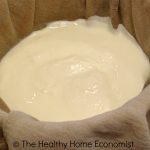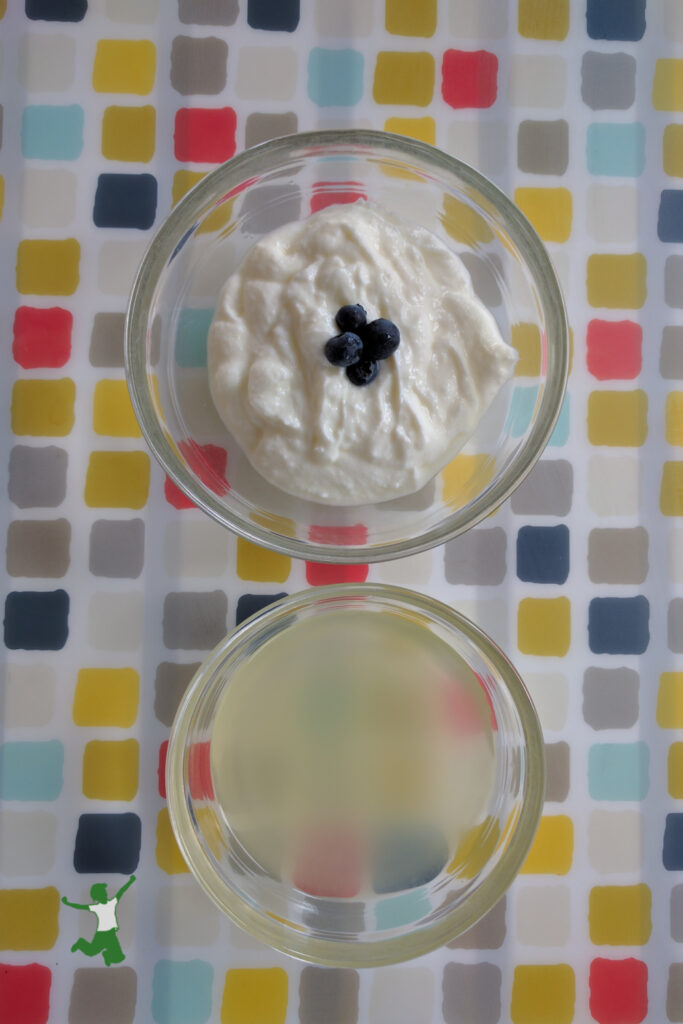Easy, fast, and frugal method of making Greek yogurt at home by straining regular yogurt that you buy from the store or make yourself.

Greek yogurt is a popular food due to its low carb content compared with regular yogurt.
When properly made, it is a good source of protein and probiotics, although Greek yogurt compared to regular is a lower source of minerals.
This is the nutritional effect of removing most of the whey, which results in the thicker texture.
Ounce for ounce, Greek yogurt is more expensive than regular yogurt, so it really pays to know how to make it yourself (my Greek yogurt hack detailed below!).
When I compared a few organic brands of Greek yogurt to regular organic yogurt in stores in my area, the higher price per ounce was considerable.
The price premium ranged from 38% to as much as 193% depending on the size container or comparing prices within the same brand or between brands.
Yogurt Life Hack
If you prefer Greek style yogurt for dietary or texture reasons, the price comparisons to regular yogurt may be discouraging.
The great news is that making Greek yogurt from regular yogurt is very easy and surprisingly fast.
Hint: Be sure to buy only the best yogurt brands before you get started.
The secret is understanding that the difference between Greek yogurt and regular is simply the amount of whey each contains.
Liquid whey is the carbohydrate and mineral-rich clear liquid that you see on the top of a container of plain whole milk yogurt. It also contains small amounts of protein.
Have you ever noticed that this liquid is greatly reduced in a container of Greek yogurt?
All you have to do is strain away about half of this liquid and you will have transformed budget-friendly regular yogurt into the premium-priced Greek version.
The trick is not to strain off all the whey else you will end up with yogurt cheese.
Yogurt cheese is very firm and lacks the spoonability and slight, natural sweetness of Greek yogurt that the carbohydrate-rich whey imparts.
In my experience, it only takes 10-15 minutes to strain enough liquid whey from regular yogurt to achieve the texture of the thicker Greek yogurt.
Bonus! Lots of Leftover Whey
The leftover whey from straining regular yogurt into Greek style is useful for so many dishes!
It can be blended into smoothies for a protein and mineral-rich boost.
Alternatively, probiotic-rich liquid whey is highly useful as a starter for fermented foods and beverages.
Examples are homemade pickles, beet kvass, orangina, Hindu lemonade, sauerkraut or mango chutney.
There are many other fermented dishes and cultured beverage recipes on this blog that use liquid whey as the starter.
Raw vs Pasteurized Greek Yogurt
Does it matter whether you use 24-hour raw yogurt or pasteurized store yogurt to make Greek-style at home?
There are certainly nutritional, probiotic, and enzymatic advantages to using raw yogurt that is properly fermented to make your Greek style version.
However, if you prefer to use store yogurt (Bulgarian yogurt is the best) to strain into Greek style, the process for making it is exactly the same.

How to Make Greek Yogurt in 10 Minutes!
Easy, fast, and frugal method of making Greek yogurt at home by straining regular yogurt that you buy from the store or make yourself.
Ingredients
- 2 cups Plain whole milk yogurt preferably fermented for 24 hours
Instructions
-
Line a medium-sized glass bowl with a thin, white floursack cloth (I use these). Carefully pour in the regular yogurt (either raw or pasteurized) in the middle of the cloth.

-
Tie up the ends of the cloth with a rubber band and attach to the knob or handle of an upper kitchen cabinet with the glass bowl directly underneath.
Another method is to tie a thick knot with the ends and wedge it inside the cabinet door to secure (see video below).

-
Allow the liquid whey to drip into the bowl for 10-15 minutes. About 1/2 cup of whey will drip into the bowl in that amount of time.
-
Carefully remove the bag of yogurt from the cabinet door and place into a clean bowl. Unfold the ends and scrape out the Greek yogurt into a clean glass container.
-
The leftover liquid whey should be refrigerated in a small glass mason jar with a lid. It will last up to 6 months and is useful as starter for fermented recipes.
Recipe Video









Thanks. In France we have plenty of fromage blanc, but Greek yogurt is actually very difficult to find… And when you find some, it’s often not from Greece and made of cow’s milk.
Thanks to you, I womt have to check the labels anymore !
I just purchased a yogurt maker that makes 2 litres It’ supposed to be easy but it isn’t thanks to this site I will not follow their instructions. I will purchase a container and make regular yogurt which takes 10 to 12 hrs I will keep the container with the strainer and poor the regular yogurt into it and refrigerate. If I used the other container without the strainer I would have to pour it into a bowl wash out the container and dry place the strainer into clean container and pour the yogurt back into the container and let drain, pour the finished yogurt into a container and refrigerate. Saves time and guessing. Or just leave the regular yogurt as is and drain the next day. I hope that makes sense.
I have been doing this for years. Why make it hard? I just place two layers of cheese cloth in a strainer …place over a bowl. Pour the regular yogurt into it. come back in a few minutes…….YOGURT!
Easy peasy. Greek yogurt in a snap.
This worked perfectly. Thank you Sarah for such a simple, easy recipe to save money. I’ve always thought Greek yogurt was so overpriced.
I have tried twice to strain the yogurt with cheesecloth and each time the yogurt just falls right though. Am I doing something wrong or do I just need more layers?
The directions don’t specify to use a cheesecloth. They say to use a dishcloth or floursack cloth. A cheesecloth does not work for this recipe for the reason that you have already discovered.
I’ve always been confused about the strained vs. not strained issue. It makes more sense now. If you go to a cheese making supplier, Greek yogurt is a different culture, different bacteria therefore different taste. I always thought it had a larger number of different bacteria strains than plain yogurt. But it doesn’t necessarily make a thicker yogurt, especially with raw milk. So somewhere along the line, American food companies decided to use that term for strained yogurt. So once again, consumer beware. If you want the Greek yogurt with a different flavor, you have to make it yourself.
Huh?… I grew up near Greece and I eat “Greek yogurt” (which was the only kind of yogurt available) and make my own Greek yoghurt, all the time. All you do is add culture to the milk and the bacterias will do the work for you. Sometimes it comes out with more whey, sometimes with less. It doesn’t matter – it is still the same cultured yogurt. The amount of the whey depends of the temperature of the milk at the moment I am adding the culture to it. The amount of whey doesn’t make it a greek yoghurt or not a greek yogurt. You can strain greek yoghurt, and it will be “Strained Greek yogurt”, which is thicker, and is used in preparing certain dishes. You can eat it strained or not strained, depends of how you like it. That’s all there is to it.
In the United States, “Greek” yogurt is always the strained kind. This results in a nutritional profile that is higher in fat and protein than regular yogurt. The amount of whey is the difference. The whey contains the carbs (lactose) and the minerals. And yes, yogurt is pretty much yogurt if you examine it from a probiotic perspective.
I think the reason stained Greek yogurt became so popular in the US is because manufacturer’s pushed it … also the low carb craze and the rise of whey protein powder. Greek yogurt manufacturers sell off the leftover whey from manufacturing (strained) Greek yogurt and it is powderized into whey powder. Much more profitable for them this way than selling unstrained “regular” yogurt.